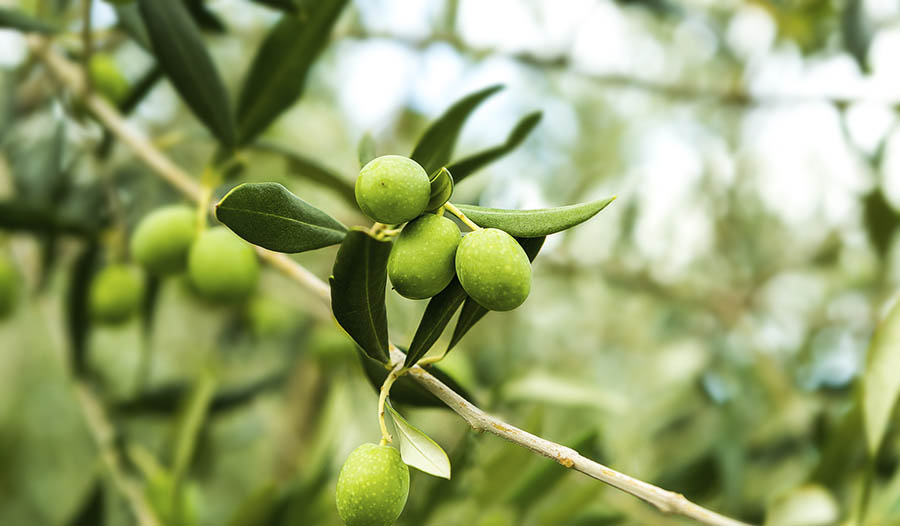8 Health Benefits of Olive Leaf Extract
DISCLAIMER:This blog does not intend to provide diagnosis...
- In this article:
- Cardiovascular Disease
- High Blood Pressure
- Diabetes
- Brain Function
- Antifungal, Antiviral and Antibacterial
- Skin Health
- Weight Management
- How to Use Olive Leaf Extract:

Many of us are familiar with olive oil and its benefits but have little to no awareness of the powerful benefits of olive leaf extract (OLE). Also referred to as oleuropein, the name of its main component, Olive Leaf Extract is derived from the leaves of the plant that bears olives, a tree called Olea Europaea. It is believed by many to help prevent cardiovascular disease, diabetes, cancer, and other conditions.
Olive leaf extract has been shown to be safe and has been widely used as traditional medicine in countries such as Greece, Spain, France, Turkey, Israel, Morocco, and Tunisia. In Egypt, it has been used for hundreds and even thousands of years. It is commonly consumed in supplement form and as a tea.
Cardiovascular Disease
Heart disease is a leading killer in the United States, Europe, and Asia. Unfortunately, as more countries adopt the Western lifestyle in place of their ancestral diets, heart disease will continue to progress. In the United States, alone, deaths due to heart and vascular disease unnecessarily kill almost 1 million people every year.
Advanced glycation end products have been associated with cardiovascular disease. In a 2016 study in Food Research International, conducted by Dr. Mata Navarro and colleagues, it was shown that olive leaf extract inhibited the formation of the advanced glycation end products, thereby helping to prevent heart disease and vascular disease.
High Blood Pressure
High blood pressure, or hypertension, is one of the leading risk factors for heart disease. More than 1 billion of the world’s 7.6 billion people have high blood pressure, which occurs when the systolic blood pressure is measured at 140 or more and diastolic blood pressure is 90 or more.
A 2016 study in Food & Function showed that olive leaf extract could help lower blood pressure. A 2011 study in Phytomedicine showed olive leaf extract, at a dose of 500 mg twice per day, could lower blood pressure similarly to the pharmaceutical drug captopril at 25 mg twice per day. No side effects were noted from the supplement.
Diabetes
Diabetes mellitus type 2, or diabetes as it is commonly known, is a condition that affects millions worldwide. Those with diabetes suffer from elevated sugar (glucose) levels in the blood, causing oxidative damage to blood vessels, nerves, and organs, such as the kidneys and eyes—an example of oxidation is when car becoming rusty from the effects of weather. Diabetes increases one’s risk of having a heart attack, stroke, foot amputation, and kidney failure.
Ninety-five percent of those with diabetes have type 2 diabetes, and five percent have type 1. Type 2 diabetes is primarily a disease of lifestyle while type 1 is due to an autoimmune destruction of the pancreas.
Olive leaf polyphenols improve insulin sensitivity, meaning that one’s insulin works more efficiently. In a 2013 study in New Zealand, 46 men were selected to receive a capsule with olive leaf extract or a placebo for 12 weeks. Those who received the olive leaf extract showed a one percent improvement in insulin sensitivity. Many studies support the idea that olive leaf extract helps in regulating blood sugar fluctuations.
Brain Function
Brain disorders are expected to rise over the next several decades. These induce dementia, Alzheimer’s disease, and Parkinson’s disease, among others. A healthy diet and physical activity are crucial to keeping the brain healthy. Certain supplements can also be helpful, (Learn more about natural approaches to Alzheimer’s disease) including olive leaf extract.
Olive leaf extract has been found to have antioxidant and brain-protective effects. A 2017 study in Metabolic Brain Disease using animals showed benefit. In that study, test subjects who received olive leaf extract had significantly improved balance, muscle strength, and antioxidant levels in the brain. The findings support that olive leaf extract has brain protecting properties and may be useful in preventing the death of specific brain cells called dopaminergic neurons, which can lead to Parkinson’s disease. For this reason, it has been suggested that olive leaf extract may be useful to patients with Parkinson’s disease and may provide some protection against Alzheimer’s disease.
A study in the European Journal of Pharmacology using an animal model showed olive leaf extract could also reduce long-term complications from a stroke.
Antifungal, Antiviral and Antibacterial
In a study in Current Medical Mycology from 2015, it was found that olive leaf extract exhibited anti-yeast effects against Candida albicans. Candida albicans is a pathogenic yeast that is found on the skin and in the human gut flora. In a different study, 150 plant extracts, including olive leaf extract, were analyzed for antiviral activity. The findings showed that olive leaf extract also had strong ability to kill viruses and may be useful in the treatment of infections caused by viruses.
Furthermore, a 2017 study in the Journal of Food Medicine showed olive leaf extract to have antibacterial properties against gram-positive bacterial strains such as staphylococcus and streptococcus.
Skin Health
A 2014 study in Cell Journal evaluated olive leaf extract used in the treatment of skin diseases and wounds. Using an animal model, mice received a one-centimeter long full-thickness incision and were left unsutured (the wound was not sewn shut). Some mice were treated with topical olive leaf extract for seven days and others with only purified water. The wounds were analyzed and it was found that olive leaf extract, when applied directly to the wound, helped with skin and wound healing.
This may be useful in the recovery process after cuts and surgery. Also, due to the antioxidant properties that are in olive leaf extract, it can help prevent skin from cell damage. One study even showed that olive leaf extract could also help protect against skin aging.
Weight Management
A 2014 study in Evidence-Based Complementary and Alternative Medicine found that olive leaf extract can help against obesity by turning off the genes that create fat (thermogenesis). The results of the study are supportive that taking olive leaf extract may help in weight loss.
How to Use Olive Leaf Extract:
The most convenient way to receive the benefits of olive leaf extract is to purchase it in a capsule or tablet form as a natural supplement. Olive leaf extract can also be purchased in liquid form.
- Olive leaf extract suggested dose: 500 mg once to twice per day
- Olive leaf extract liquid: Take as directed on the label
Although there is still much research to be done on olive leaf extract, there is enough evidence to support that it is beneficial to overall health and well-being.
References:
- El SN, Karakaya S (2009) Olive tree (Olea europaea) leaves: potential beneficial effects on human health. Nutr Rev67: 632–638
- Navarro Mata, Fransisco J Morales. Evaluation of an Olive leaf extract as a natural source of antiglycative compounds. Institute of Food Science, Technology and Nutrition (ICTAN-CSIC), Madrid, Spain https://doi.org/10.1016/j.foodres.2016.12.017
- Endocr Metab Immune Disord Drug Targets. 2017 Nov 15. doi: 10.2174/1871530317666171116110537. [Epub ahead of print]
- Romero, M, Toral N, Gomez-Guzman M, Jimenez R. (2015), Antihypertensive effects of oleuropein-enriched Olive leaf extract in spontaneously hypertensive rats. Food Funct. 2016 Jan;7(1):584-93. doi: 10.1039/c5fo01101a.
- Phytomedicine. 2011 Feb 15;18(4):251-8. doi: 10.1016/j.phymed.2010.08.016. Epub 2010 Oct 30.
- De Bock M, Derraik JGB, Brennan CM, et al. Olive (Olea europaea L.) Leaf Polyphenols Improve Insulin Sensitivity in Middle-Aged Overweight Men: A Randomized, Placebo-Controlled, Crossover Trial. Nerurkar PV, ed. PLoS ONE. 2013;8(3):e57622. doi:10.1371/journal.pone.0057622.
- Boss A, Bishop KS, Marlow G, Barnett MPG, Ferguson LR. Evidence to Support the Anti-Cancer Effect of Olive leaf extract and Future Directions. Nutrients. 2016;8(8):513. doi:10.3390/nu8080513.
- Biomed Pharmacotherapy. 2017 Jun;90:713-723. doi: 10.1016/j.biopha.2017.04.022. Epub 2017 Apr 15.
- Marchetti C, Clericuzio M, Borghesi B, et al. Oleuropein-Enriched Olive leaf extract Affects Calcium Dynamics and Impairs Viability of Malignant Mesothelioma Cells. Evidence-based Complementary and Alternative Medicine : eCAM. 2015;2015:908493. doi:10.1155/2015/908493.
- J Pharm Biomed Anal. 2015 Feb;105:156-62. doi: 10.1016/j.jpba.2014.11.048. Epub 2014 Dec 11.
- Sarbishegi, M., Charkhat Gorgich, E.A., Khajavi, O. et al. Metab Brain Dis (2017). https://doi.org/10.1007/s11011-017-0131-0
- Hailong Yu, Peipei Liu, Hui Tang, Jian Jing, Xiang Lv, Lanlan Chen, Li Jiang, Jun Xu, Jun Li, Oleuropein, a natural extract from plants, offers neuroprotection in focal cerebral ischemia/reperfusion injury in mice, In European Journal of Pharmacology, Volume 775, 2016, Pages 113-119, ISSN 0014-2999
- Nasrollahi Z, Abolhasannezhad M. Evaluation of the antifungal activity of olive leaf aqueous extracts against Candida albicans PTCC-5027. Current Medical Mycology. 2015;1(4):37-39. doi:10.18869/acadpub.cmm.1.4.37.
- Knipping, Karen, Johan Garssen, and Belinda van’t Land. “An Evaluation of the Inhibitory Effects against Rotavirus Infection of Edible Plant Extracts.” Virology Journal 9 (2012): 137. PMC. Web. 17 Dec. 2017.
- Qabaha Khaled, AL-Rimawi Fuad, Qasem Ahmad, and Naser Saleh A.. Journal of Medicinal Food. November 2017, ahead of print. https://doi.org/10.1089/jmf.2017.0070
- Mehraein F, Sarbishegi M, Aslani A. Evaluation of Effect of Oleuropein on Skin Wound Healing in Aged Male Balb/c Mice. Cell Journal (Yakhteh). 2014;16(1):25-30.
- Sumiyoshi, M. and Kimura, Y. (2010), Effects of Olive leaf extract and its main component oleuroepin on acute ultraviolet B irradiation-induced skin changes in C57BL/6J mice. Phytother. Res., 24: 995–1003. doi:10.1002/ptr.3048
- Ying Shen, Su Jin Song, Narae Keum, and Taesun Park, “Olive leaf extract Attenuates Obesity in High-Fat Diet-Fed Mice by Modulating the Expression of Molecules Involved in Adipogenesis and Thermogenesis,” Evidence-Based Complementary and Alternative Medicine, vol. 2014, Article ID 971890, 12 pages, 2014. doi:10.1155/2014/971890

 By Dr. Eric Madrid, M.D.
By Dr. Eric Madrid, M.D.


